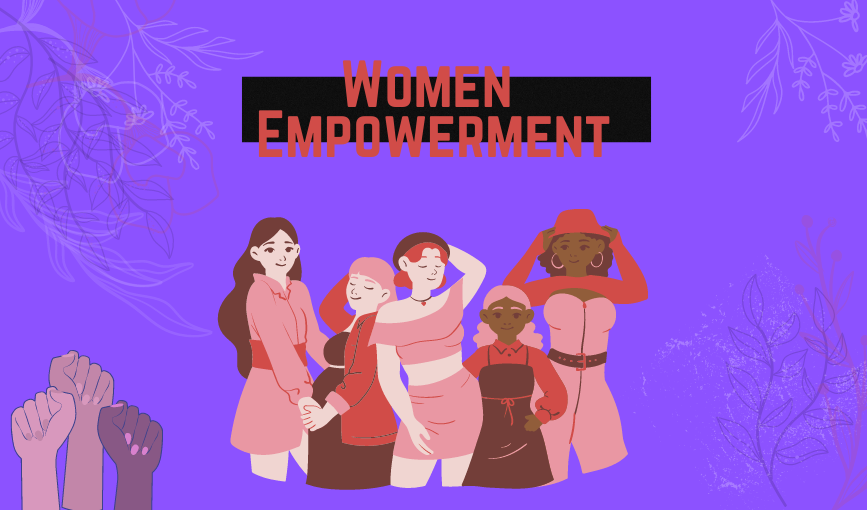“Empowered Women, Empowered World!”
Introduction: In our quest for a more inclusive and equitable society, empowering women stands as a paramount objective. Recognizing the immense change. This blog explores the multifaceted aspects of women’s empowerment and highlights the positive impact it can have on communities, economies, and the world at large.

1. The Power of Empowering Women
(i)Promoting Equal Opportunities: Empowering women starts with ensuring equal opportunities in all areas of life. This means breaking down barriers that hinder women’s access to education, employment, and leadership roles. By providing a level playing field, we enable women to develop their skills, talents, and ambitions, allowing them to make meaningful contributions to society. (ii)Challenging Gender Norms: To truly empower women, we must challenge and dismantle harmful gender norms and stereotypes. These limiting beliefs place unfair expectations and restrictions on women, preventing them from fully realizing their potential. By promoting gender equality and embracing diverse expressions of femininity, we create an environment where women can thrive authentically and without limitations.


2. Education: Illuminating Pathways to Success
(i)Equipping Women with Knowledge and Confidence: Education serves as the foundation for women’s empowerment. Access to quality education equips women with knowledge, critical thinking skills, and the confidence to pursue their dreams. By removing barriers to education and promoting lifelong learning opportunities, we open doors for women to shape their own destinies and contribute to society.
(ii)Empowering Future Generations: Educated women become agents of change and role models for future generations. When women are empowered through education, they pass on their knowledge, values, and aspirations to their children. This creates a positive ripple effect, where educated women raise empowered daughters and sons who value gender equality, thus contributing to long-term societal transformation.
(iii)Promoting Lifelong Learning: Education is not limited to formal schooling; it encompasses lifelong learning. Encouraging women to pursue continuous education and skill development equips them with the tools needed to adapt to evolving societal needs. By promoting lifelong learning opportunities, we ensure that women remain empowered, resilient, and capable of navigating a rapidly changing world.



3. Economic Empowerment: Breaking Through Barriers
(i)Fostering Financial Independence and Growth: Economic empowerment plays a crucial role in women’s journey towards equality. By promoting equal access to employment, entrepreneurship, and financial resources, we enable women to break through barriers and thrive economically. When women are economically empowered, they can support their families, drive economic growth, and become agents of change in their communities.
(ii)Promoting Women’s Entrepreneurship: Entrepreneurship is a powerful avenue for women’s economic empowerment. By encouraging and supporting women in starting and growing their own businesses, we provide them with the opportunity to shape their own destinies, exercise creativity, and generate economic value. Access to training, mentorship, and financial resources are critical in fostering women’s entrepreneurship.
(iii)Access to Financial Services: Access to financial services, including credit, banking, and savings accounts, is crucial for women’s economic empowerment. By improving financial literacy, expanding microfinance initiatives, and removing discriminatory practices, we create an enabling environment for women to access and utilize financial resources to invest in their businesses and secure their financial future.
(iv)Balancing Work and Family Responsibilities: Addressing the challenge of work-life balance is crucial in empowering women economically. Implementing family-friendly policies, such as flexible working hours, parental leave, and affordable childcare options, enables women to pursue their professional goals while fulfilling their caregiving responsibilities. By creating supportive environments, we empower women to thrive both personally and professionally.
4. Leadership and Decision-Making: Shaping a Better Future
(i)Women at the Forefront of Progress: Women’s representation in leadership and decision-making positions is vital for creating inclusive and sustainable societies. By breaking gender barriers and encouraging diverse participation, we unlock the potential for innovative solutions, effective governance, and policy changes that address the needs of all. Empowered women leaders become role models and pave the way for future generations.
(ii)Promoting Women’s Leadership in the Workplace: Increasing women’s leadership and decision-making roles in the workplace is essential for economic empowerment. By breaking through glass ceilings and creating inclusive corporate cultures, we encourage women to ascend to leadership positions where they can influence organizational strategies, policies, and practices. Women leaders serve as role models and catalysts for change, inspiring other women to pursue their own career aspirations.


5. Health and Well-being: Nurturing Strength and Resilience
(i)Ensuring Holistic Care and Rights: Women’s health and well-being are essential aspects of empowerment. Accessible healthcare, reproductive rights, and the eradication of gender-based violence are crucial in fostering women’s well-being. By promoting comprehensive support systems, we enable women to thrive physically, mentally, and emotionally, empowering them to contribute fully to society.
(ii)Mental Health Support: Recognizing and addressing mental health issues is vital for empowering women. Women face unique stressors and are more prone to conditions like anxiety and depression. Providing access to mental health services, promoting self-care practices, and reducing the stigma associated with seeking help are crucial steps in nurturing resilience and strength.

6. Challenging Gender Stereotypes: Redefining Boundaries
(i)Embracing Individuality and Choice: Challenging gender stereotypes is a pivotal step in empowering women. By breaking free from societal expectations and embracing individuality and choice, women can pursue their passions and aspirations without limitations. Celebrating women who defy stereotypes inspires others and encourages a more inclusive and diverse society.
(ii)Gender Equality and Empowerment: Empowering women involves addressing gender inequalities and discriminatory practices that limit their access to resources and opportunities. By promoting equal rights, eliminating gender-based violence, and providing economic opportunities, we can enhance women’s resilience and overall well-being.
7. Legal and Policy Support: Ensuring Equality and Justice
(i)Advocating for Women’s Rights: Supportive legal and policy frameworks are fundamental to women’s empowerment. By advocating for and enforcing laws that protect women’s rights, address discrimination, and promote gender equality, we create an enabling environment for women to thrive. Equal opportunities in employment, education, and decision-making contribute to a more just and equitable society.
(ii)Anti-Discrimination Measures: Implementing measures to prevent and address gender-based discrimination is essential. This includes laws and policies that prohibit discrimination in the workplace, housing, public services, and other domains. Efforts should be made to eliminate stereotypes, biases, and prejudices that hinder women’s progress and limit their opportunities.
(iii)Legal Protection against Gender-Based Violence: Laws should provide strong protection against gender-based violence, including domestic violence, sexual assault, harassment, and trafficking. These laws should criminalize such acts, establish mechanisms for reporting and investigating incidents, and ensure support services for survivors. Legal measures should prioritize the safety and well-being of women, ensuring their access to justice and effective remedies.
(iv)Sexual and Reproductive Rights: Legal and policy support should guarantee women’s sexual and reproductive rights. This includes access to comprehensive sexual education, contraception, safe abortion services, maternal healthcare, and support for reproductive health issues. Women should have autonomy and control over their reproductive choices and be free from coercion or discrimination.
(v)Maternity and Parental Rights: Laws should protect maternity rights and ensure that women can balance their family responsibilities with their professional lives. This includes maternity leave, parental leave, and policies that support work-life balance. Adequate support should be provided to promote the involvement of men in caregiving and parenting responsibilities.
8. Engaging Men as Allies: Promoting Partnership for Change
(i)Building Bridges for Gender Equality: Engaging men as allies is vital in the pursuit of gender equality. By promoting respectful relationships, challenging harmful gender norms, and fostering dialogue and collaboration, we build a more inclusive society. Men’s active participation as allies and advocates amplifies the impact of women’s empowerment efforts and contributes to lasting change.
9. Technology as an Enabler: Bridging the Digital Divide
(i)Harnessing Innovation for Women’s Empowerment: In the digital age, technology plays a pivotal role in women’s empowerment. Bridging the digital divide and promoting digital literacy enable women to access information, resources, and economic opportunities. By harnessing the power of technology, we can empower women to overcome barriers and participate fully in the digital world.
(ii)Social Support Networks: Online platforms and social media provide women with opportunities to connect, collaborate, and form support networks. Women can join online communities, share experiences, and seek advice from peers, fostering a sense of belonging and support. These digital networks can be particularly empowering for marginalized women, allowing them to find solidarity and amplify their voices.
(iii)Safety and Security: Technology can also contribute to women’s safety and security. Mobile applications, wearable devices, and emergency alert systems provide women with tools to enhance their personal safety and seek help in case of emergencies. Moreover, technology can facilitate reporting and documentation of gender-based violence, helping to address and prevent such incidents.


Conclusion: Empowering women and unleashing their potential for change is a collective responsibility that leads to a more equitable and prosperous world. By addressing the diverse aspects of women’s empowerment highlighted in this blog, we can create an environment where women thrive, contribute, and shape a brighter future. Together, let us champion women’s empowerment and celebrate their invaluable role in driving positive transformation.
WRITER

